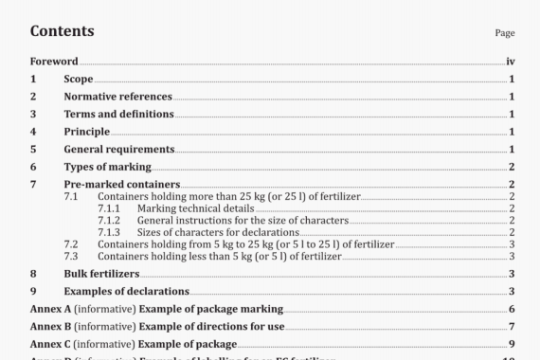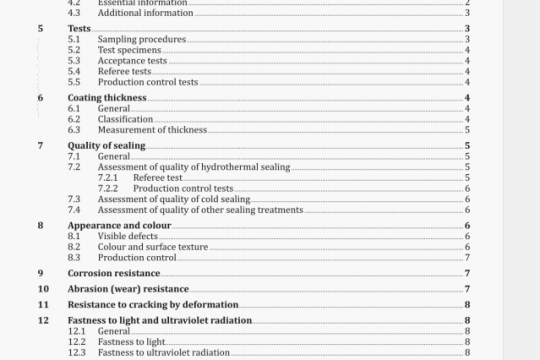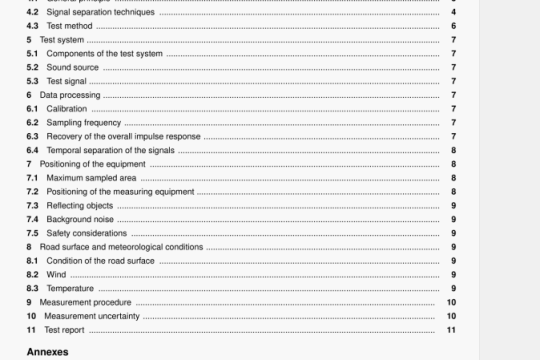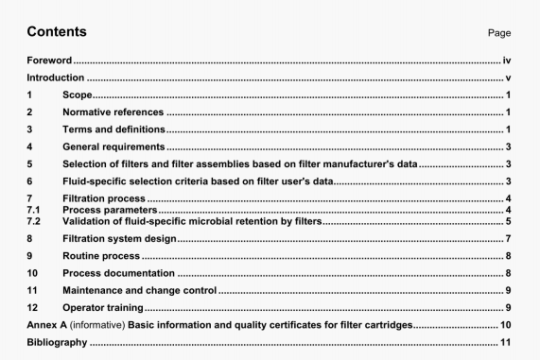ISO 15913:2000 pdf download
ISO 15913:2000 pdf download.Water quality – Determination of selected phenoxyalkanoic herbicides, including bentazones and hydroxybenzonitriles by gas chromatography and mass spectrometry after solid phase extractionand derivatization.
9.1.2 Enrichment and derivatization
Measure the volume of the sample (see clause 8) (for example 1 000 ml) in a graduated cylinder or by weighing.
Adjust the pH with hydrochloric acid (6.4) to (2 ± 0,2).
If calibration is carried out using an internal standard, add 10 jil of the commercially available internal standard (6.14), or 1 ml of the dilute internal standard solution (6.14).
Run the water sample at a regulated flow rate of <1 000 mI/h over the adsorbent material previously conditioned according to 9.1.1. (Regulate the flow rate by altering the vacuum or the overpressure, respectively).
After enrichment, dry the adsorbent with an inert gas, for instance in a nitrogen stream (6.3) (30 mm, at a flow rate of approximately 100 mI/mm at room temperature).
Elute in small portions with at least 4 ml of eluent (6.9) per 1 g of RP-C1 8 material.
Add half of the solvent (6.9) to the column (cartridge) and allow to equilibrate (for instance for 10 mm).
Add the remaining solvent and collect the eluent in a small volumetric flask.
Transfer any remaining eluent from the adsorbent by means of vacuum or pressure into the volumetric flask.
Carefully evaporate the solvent under a stream of nitrogen, nearly to dryness, and carry out the derivatization step immediately.
9.1.3 Derivatization with diazomethane
Add 0,5 ml of diazomethane solution (6.15) to the evaporated extract (9.1.2) or to the standard solution, respectively, to react in the dark for 1 h. The residual solution shall remain yellow, otherwise add more diazomethane. Note the solvent volume, V01, used for dissolution. Evaporate the solvent almost to dryness using a stream of nitrogen and dissolve the residue acetone (6.9).
9.2 Blank monitoring
The proper condition of instruments and reagents shall be checked by blank monitoring at regular intervals, at least each time after any change has been made.
For the blank measurements prepare and analyse 1 000 ml of water (6.1) in the same way as the sample.
If the blanks are higher than the limit of determination, systematic investigations shall be carried out to detect and
consequently eliminate the source of contamination.
9.3 Determination
9.3.1 Operating conditions — Gas chromatography
Optimize the instrumental parameters as described in the operator’s manual.
Use a capillary column (7.9) for the separation (see annex D, key to Figures D.5 and D.6).
Ensure that the compounds of interest are separated sufficiently to allow proper identification.
NOTE Identification by retention times and spectra data may be supported by the available methyl ester reference substances (6.16.1).
If only single masses are registered in order to increase the sensitivity, register the base peak and at least 2 more ions (if within the spectrum), with the same cycle duration as above.
Consider individual compounds in the sample to be identified if:
— the retention times (tR) of the respective peaks in the total ion-current chromatograms or in the individual mass chromatograms lie within a tolerance of 1R = ± 0,08 mm (5 s), compared with the retention times of the peaks of the substances in the total ion current chromatograms or individual mass chromatogram of a reference solution, measured under identical conditions; and
— if complete, background-corrected mass spectra of the reference compounds agree within specified tolerances with the background corrected mass spectra obtained at the respective retention time in the total ion-current chromatogram of the sample; or
if at least the characteristic molecular ions or fragment ions of the reference compounds (see Table 2) agree, within specified tolerances, with those of the compounds to be identified as to their relative peak intensities.
NOTE 1 Generally, after background correction, no ion with greater mass should be present in the mass spectrum than the greatest possible mass for a compound being identified.
NOTE 2 The identification via the molecular ion or via a main fragment ion is often not sufficient for an identification, therefore, at least a further typical fragment mass should be used for confirmation.
NOTE 3 Low limits of detection can be achieved by identification via single mass detection with individual mass recording (SIM technique) or with multiple mass recording (MID technique). However, less information is obtained from these techniques. Therefore SIM and MID should be used only with a certain knowledge of the sample matrix. With inadequate background information of the sample to be investigated at least two further characteristic masses should be examined to get an additional confirmation.
9.4 Calibration
9.4.1 General requirements
For practical reasons, use reference standards.
Use the same injection volume for calibration as for the measurement of the sample solutions.
For each compound a separate calibration function and graph, consisting of at least five points from five different concentrations, shall be established.




